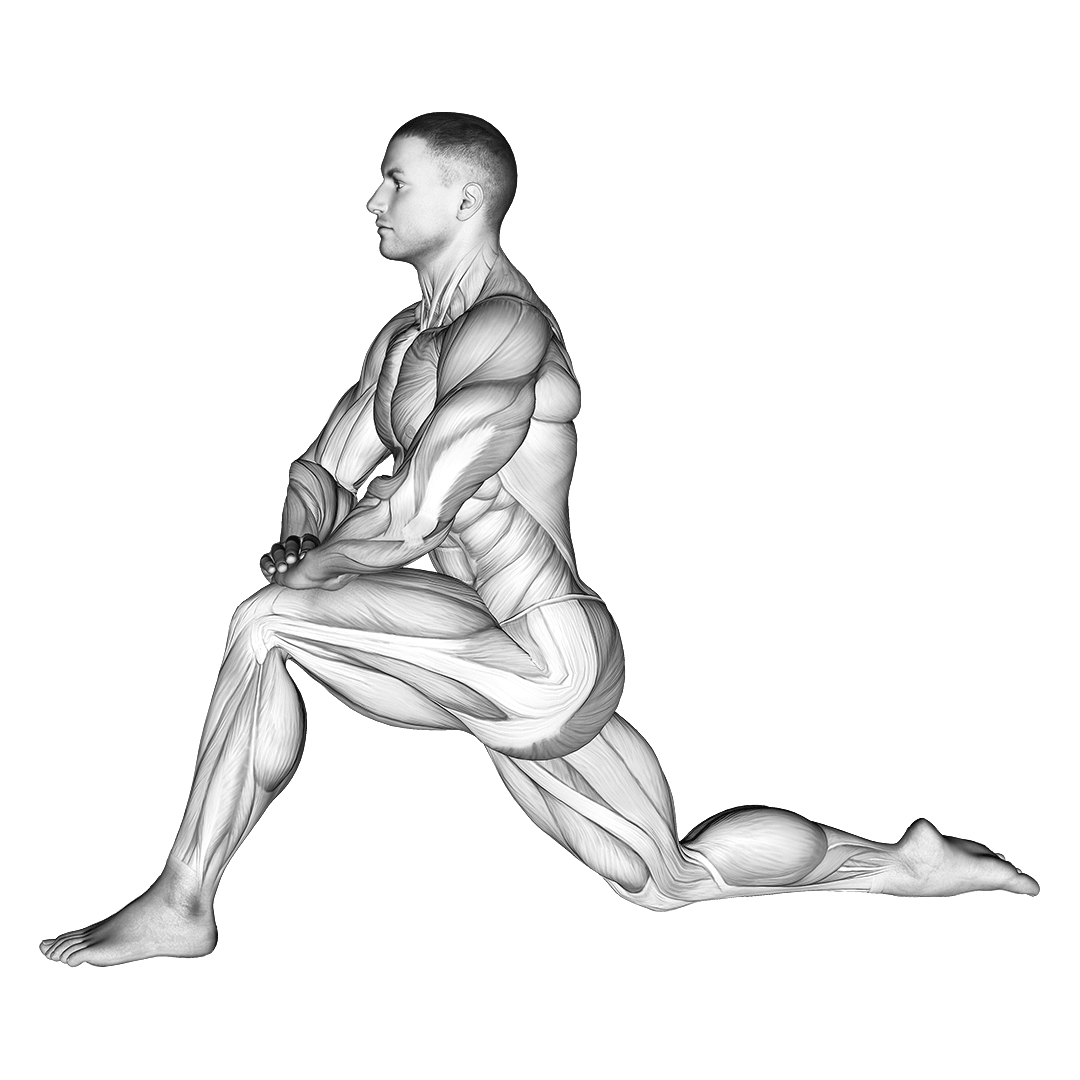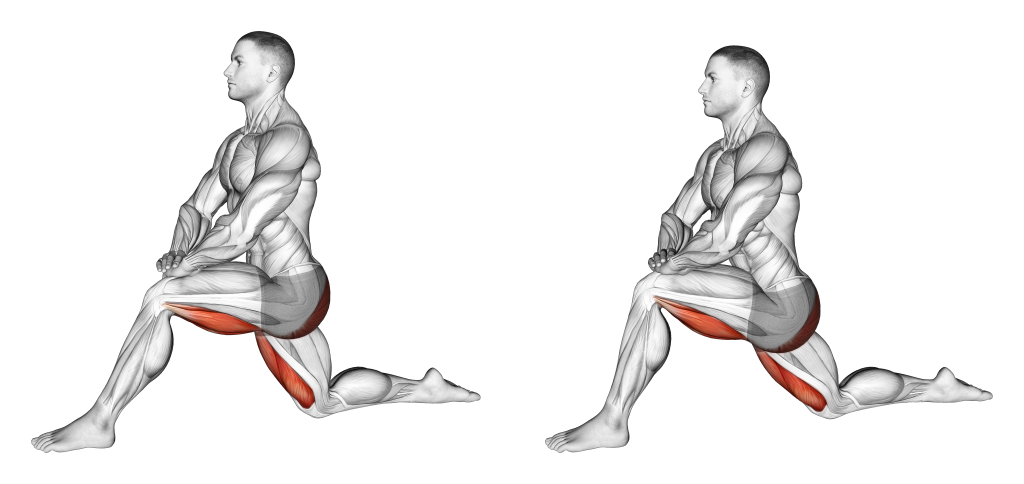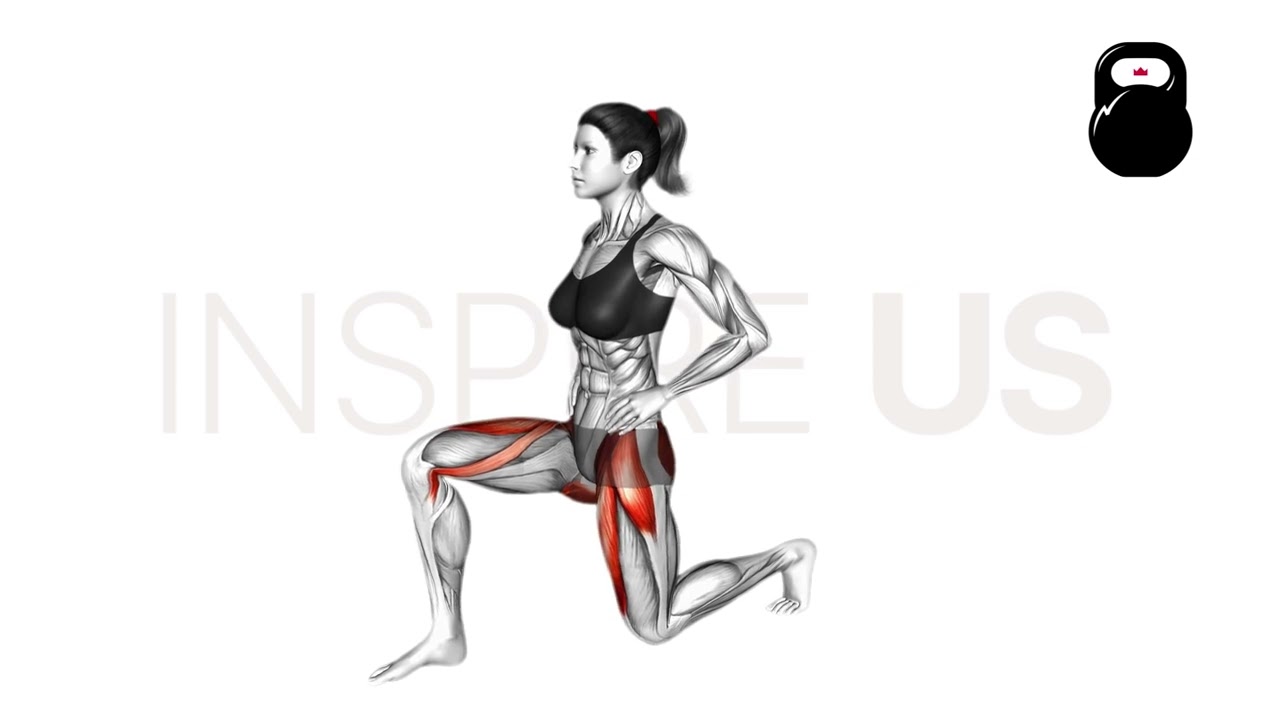Kneeling Lunge Stretch Exercise Overview: Muscles Worked and More
The kneeling lunge stretch is an active mobility exercise meant to improve the flexibility of the hip flexor muscles and the general mobility of the lower body itself.
Apart from stretching the hip flexors, this movement will also target the tendons of the knees and those on the posterior side of the ankle.
Kneeling Lunge Stretch at a Glance
Equipment Requirements
None
Main Muscles Targeted
Hip Flexors
Difficulty
Easy
Sets, Reps, and Load Recommendations
2-3 Sets of 10-20 Repetitions on Each Side
How to Do a Kneeling Lunge Stretch
- To perform a repetition of the kneeling lunge stretch, the exerciser begins by kneeling down on one knee, planting the opposite foot several inches ahead of the hips.
The upper body itself should be vertically aligned with as little posterior pelvic tilt as possible, instead tending towards anterior tilt by leaning the upper chest slightly backwards. - Now positioned correctly, the exerciser pushes their hips forwards while keeping their forefoot planted - allowing the knee to bend past the toes and the rear leg to stretch out at the hip.
- Once reaching the limits of their hip or ankle mobility, the exerciser reverses the motion until they have returned to their original position with the forward-facing knee over the ankle.
- The repetition is considered complete. Repeat with the opposite side of the body in equal volume.
Additional Tips:
For exercisers with poor knee mobility, the kneeling hip stretch may be uncomfortable or even painful to perform. In such cases, performing the exercise with the back knee elevated will help keep the knees behind the toes.
Another tip for maximizing the stretch is to press the hand of the same side down on the foreleg, keeping the trunk upright and helping maximize the stretch of the hip flexor by keeping the femur horizontal.
What Muscles Does the Kneeling Lunge Stretch Target?
The kneeling lunge stretches quite a few joints and muscles throughout the lower body, especially if the exerciser has an already well-established level of hip mobility.

Apart from targeting the hip flexors quite effectively, the stretch itself also stretches the quadriceps to a small degree, the posterior shin tissues and has some small lengthening effect on the foreleg’s hamstrings.
In terms of joints mobilized, the hips are worked through a range of flexion/mild rotation, as are the knees and the ankles.
Common Kneeling Lunge Stretch Mistakes to Avoid
In healthy populations, the kneeling lunge stretch is considered to be quite a safe mobility exercise.
However, despite this, regularly performing the following mistakes may lead to an inefficient or even injurious movement unless otherwise corrected.
Seating the Hips Back
During the initial half of the movement, the hips must be pushed forwards so as to lengthen the hip flexor to a sufficient degree.

Doing the opposite and pushing the hips back can have quite the opposite effect, and will essentially turn the stretch into a kneeling squat instead.
To avoid making this particular mistake, the exerciser can focus on pushing their knee forwards - of which should subsequently draw the pelvis forwards as well.
Rear Foot Positioned Too Close
Another common mistake seen with the kneeling lunge stretch is positioning the rear foot too close to the forward-facing foot, leading to a shorter stretch of certain muscles and limiting the effectiveness of the exercise.
Unless specifically positioning the rear foot in such a way due to poor mobility, it is best to set the knee, calf and the foot itself several inches behind the hips at the start of the set. This will ensure a sufficient stretch of the rear leg’s hip tissues is achieved.
Allowing the Knee to Collapse Inwards
Whether due to ankle eversion, poor footwear or weak adductor muscles; allowing the forward-facing knee to rotate inwards can increase strain on the hip joint and destabilize the entire body.
Exercisers having difficulty keeping their knee facing forwards (or slightly outwards) can try angling their toes several degrees outwards. Alternatively, performing the stretch barefoot or wish insoles designed to correct ankle eversion may work as well.
Bouncing or Dive Bombing Into Depth
Like most other active stretches, performing the entire movement in a slow and controlled manner is ideal for maximizing mobility and ensuring no injuries occur.
This is especially important for individuals with particularly tight hip flexors, as snapping the hips forward may lead to sprains or tears in the connective tissues of the hip joint itself.
As the exerciser pushes their hips forwards, attention must be paid to slowing down the movement and stopping if any pain or discomfort is felt. Avoid jerky or explosive and uncontrolled movements.
Who Should Do the Kneeling Lunge Stretch?
The kneeling lunge stretch is completely appropriate for the majority of healthy individuals, but may not be so for those with a history of hip, knee or ankle issues.
If performed with regularity, the kneeling lunge stretch is excellent for correcting inflexibility of the hip flexors and strengthening the tissue integrity of the entire lower body as a whole.
To err on the side of caution, speak to your physician or physical therapist prior to attempting any sort of lower body exercise.
References
1. Michael V Winters, Charles G Blake, Jennifer S Trost, Toni B Marcello-Brinker, Lynne Lowe, Matthew B Garber, Robert S Wainner, Passive Versus Active Stretching of Hip Flexor Muscles in Subjects With Limited Hip Extension: A Randomized Clinical Trial, Physical Therapy, Volume 84, Issue 9, 1 September 2004, Pages 800–807, https://doi.org/10.1093/ptj/84.9.800

